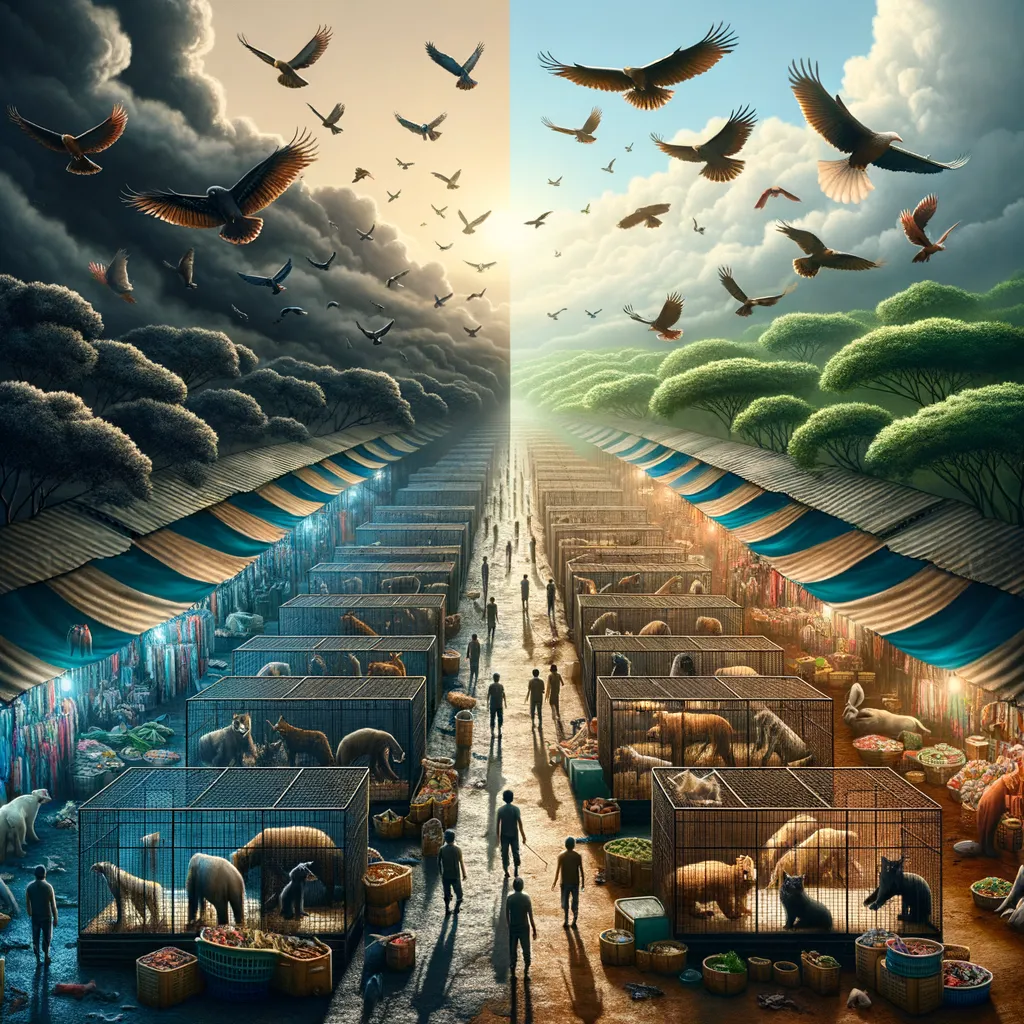Understanding Wildlife Trafficking: A Guide for Parents on Global Issues and Local Solutions
As parents, teaching our children about the beauty and importance of wildlife is essential. However, it’s also crucial to educate them about the darker side of human interaction with nature, such as wildlife trafficking. This illegal trade poses a significant threat to biodiversity and endangered species worldwide. The good news is that there are ways to fight back, and it starts with education and awareness. In this comprehensive guide, we’ll dive deep into the global issue of wildlife trafficking and discuss practical local solutions that families can implement to make a difference. Whether through making informed choices, supporting conservation efforts, or finding outdoor activities that promote a healthy respect for nature, there’s much we can do.
Looking for ways to explore nature responsibly? Visit Outdoors for gear and tips that align with conservation ethics. And if you’re trying to plan an eco-friendly camping trip, Find camping spots that are designated for sustainable tourism. Both websites are fantastic resources for parents wanting to instill a love of nature in their children while being mindful of their environmental footprint.
Why Wildlife Trafficking Matters
Wildlife trafficking is the illegal trade of animals and animal products such as ivory, rhino horn, and exotic pets. It’s a multifaceted problem that impacts not just the species being trafficked but also the ecosystems they inhabit and the communities living nearby. The loss of key species due to trafficking can disrupt food chains and weaken natural habitats, leading to long-term environmental damage. Moreover, wildlife trafficking is often linked to other forms of crime, such as corruption and drug trafficking, making it a global issue of considerable concern.
Understanding the Scale of the Issue
The scale of wildlife trafficking is both alarming and heartbreaking. It’s estimated that tens of thousands of elephants are killed each year for their ivory. Rhinos, tigers, and many species of birds and reptiles face similar fates, driven towards extinction for their parts or as exotic pets. This illicit trade not only threatens the survival of these magnificent creatures but also undermines decades of conservation efforts. Recognizing the extent of this global crisis is the first step towards combating it.
Local Solutions That Make a Global Impact
While the problem of wildlife trafficking might seem overwhelming, there are actionable steps that individuals and families can take to contribute to the solution. From the choices we make as consumers to the way we educate our children about wildlife and conservation, every action counts. In the following sections, we’ll explore practical ways for families to get involved and support the fight against wildlife trafficking.
Stay tuned as we discuss actionable strategies to educate our young ones about wildlife conservation, how to responsibly enjoy the outdoors without contributing to trafficking, and tips for practicing ethical tourism. By fostering an early appreciation for nature in our children, we can raise the next generation of conservationists and ensure a healthier planet for future generations.

Understanding Wildlife Trafficking: A Comprehensive Guide for Parents
As conscientious parents eager to cultivate a reverence for nature amongst our children, it’s crucial we address not only the wonders of wildlife but its adversities as well. Wildlife trafficking emerges as a dire global issue, posing a critical threat to biodiversity and the very essence of endangered species. This guide endeavors to delve into the intricacies of wildlife trafficking, outlining practical, actionable local solutions for families to ensure a positive impact. Through informed choices, support for conservation endeavors, and engaging in nature-positive activities, we can foster a profound respect for our natural world within our families.
Discover responsible ways to enjoy the great outdoors by visiting Outdoors for eco-aligned gear and insights. Planning an eco-conscious camping adventure? Find camping spots dedicated to sustainable tourism. These resources are invaluable for parents keen to instil an affinity for nature in their young ones, all the while minimizing their environmental footprint.
Why Wildlife Trafficking Should Concern Us
At its core, wildlife trafficking involves the illegal trading of animals and their derivatives, such as ivory, rhino horns, and exotic pets. This illicit commerce detrimentally affects not just the targeted species but the broader ecosystems and human communities. Key species depletion from trafficking disrupts food chains and debilitates habitats, leading to severe environmental repercussions. Moreover, wildlife trafficking often intertwines with other illicit activities, including corruption and drug trade, magnifying its global significance.
Grasping the Magnitude of Wildlife Trafficking
The alarming scale of wildlife trafficking brings both shock and sorrow. Annual reports estimate the poaching of tens of thousands of elephants for ivory, while rhinos, tigers, and numerous bird and reptile species verge on extinction due to their value as commodities or pets. Such rampant trade jeopardizes these species’ survival and erodes the progress of conservation efforts. Acknowledging this crisis is paramount in forging effective countermeasures.
Local Acts Generating Global Waves
The vastness of the wildlife trafficking crisis may seem daunting; however, individual and familial actions possess significant potential for contributing to its remedy. Choices made in our daily lives, coupled with how we impart knowledge of wildlife and conservation to our progeny, encapsulate impactful steps towards this cause. Weighing in on tangible solutions, we aim to empower families to actively partake in and champion the fight against wildlife trafficking.
Aligning ourselves with responsible outdoor activities, ethical tourism practices, and instilling a deep-seated appreciation for nature in our children can carve out conservationists of the coming age, securing a flourishing planet for ensuing generations. The essence of this dialogue underscores the power of early education and proactive family involvement in overturning the tide of wildlife trafficking.
Five Essential Insights for Parents Battling Wildlife Trafficking:
- Educate Through Engagement: Leverage every opportunity to educate your children about wildlife through immersive experiences. Zoos, natural history museums, and conservation parks offer educational programs that highlight the impact of trafficking on biodiversity.
- Practice Eco-Friendly Tourism: Choose vacation locales and activities that support conservation efforts and do not exploit wildlife. Research destinations in advance to ensure they adhere to ethical practices that contribute to the local ecosystem’s preservation.
- Be Mindful of Consumer Choices: Teach your family the importance of conscious consumerism. Avoid products made from endangered species or that harm the environment. Opting for eco-friendly and ethically sourced goods sends a powerful message against wildlife trafficking.
- Support Conservation Efforts: Donations to reputable wildlife conservation organizations can have a profound impact. Additionally, participating in local conservation events or clean-up drives as a family can foster a sense of responsibility and collective action towards saving endangered species.
- Advocate for Change: Encourage respectful advocacy. Teach your children the importance of raising their voices for those that cannot speak for themselves. Writing to local representatives, signing petitions, and engaging in peaceful activism can effect change at higher policy levels to combat wildlife trafficking.
Empowering our families with awareness and actionable strategies against wildlife trafficking strengthens our collective resolve to cherish and protect our natural heritage. By instilling respect for wildlife and emphasizing the gravity of trafficking, we nurture compassionate, conservation-minded individuals. Together, through engaged education, responsible tourism, conscious consumerism, active conservation support, and advocacy, we can safeguard the diversity of our planet for today’s children and tomorrow’s leaders.
Disclaimer
The articles available via our website provide general information only and we strongly urge readers to exercise caution and conduct their own thorough research and fact-checking. The information presented should not be taken as absolute truth, and, to the maximum extent permitted by law, we will not be held liable for any inaccuracies or errors in the content. It is essential for individuals to independently verify and validate the information before making any decisions or taking any actions based on the articles.




